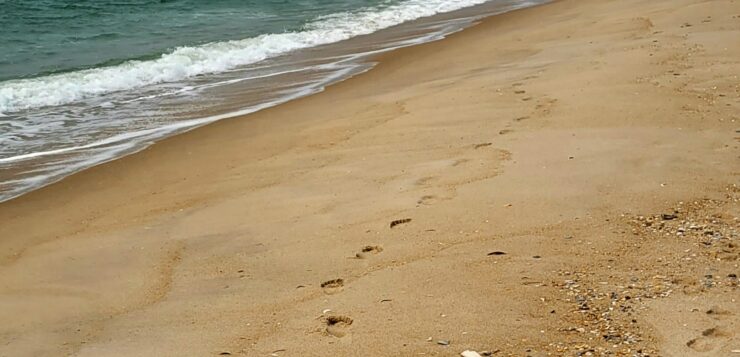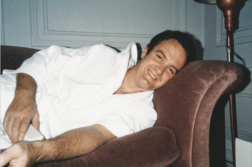
I’m sitting on a deck that hangs over the beach at Fire Island. Steps leading down to the water seem to stretch forever in both directions, wild and empty. The air sparkles with tiny crystals from the crashing waves with the warm, humid air. Looking east across the water, there is no horizon. At some point, the silver water and the sky become one.
This is my favorite beach; it’s both wild and vast, usually vacant, and yet, welcoming. Somewhere to the south of me in 1966, Frank O’Hara died after being hit by a dune buggy walking home along the beach one night.
There is a large population of deer here. I don’t think they have any natural predators, and although residents consider them a nuisance, it would be deeply unpopular to interfere with them. I consider them the magical guardians of the island. They have little, if any, fear of humans, and it’s not unusual to open the door in the morning to find one or more exploring the patio.
I first came to Fire Island with my partner Jan nearly fifty years ago. We stayed with a friend from Vancouver who had a timeshare that summer. And of course, the house had to be in The Pines because, in those days of newly liberated, young gay men, it was the place to be, as opposed to The Grove, which was rumored to be frequented by older gay men and lesbians.
Then, there was tea dance. They began in New York in the 1950s and ’60s, reaching their apogee at The Pines. My first encounter with tea dances was with Jan when we were still a newly minted couple, on our first vacation together. I’d never seen or heard of anything like it. It was on a deck adjacent to the Boatel, a boutique hotel on the island, above the dock. On our first night, after an early dinner with our host and his partner, we all headed to tea dance. It wasn’t hard to find, as the sound of the disco echoed across the island and bay, a kind of call to the bacchanal.
And there it was: A sea of dancing, half-naked men, some so entranced with the music they were completely oblivious to everything happening around them. Men danced alone, in couples, and in groups. Those groups formed, dispersed, and formed anew. And oh, did we dance! To Donna Summer— our reigning disco queen until she became ‘born again’ and nearly ended her career— Grace Jones, Thelma Houston, The Weather Girls, Gloria Gaynor, Chaka Khan, Patti Labelle, and Sylvester, one of the few gay black men.
The opening cords of “Love to Love You Baby” and “It’s Raining Men” brought everyone to the dance floor and deck. And what a mix: bespectacled skinny guys, muscle boys, men whose face and body I had seen only hours before on a billboard in Manhattan advertising Calvin Klein underwear. Once on the dance floor, all of us were equals, writhing, stomping, shouting and singing the lyrics. It was an absolute celebration of freedom, of the tearing down of the walls of bigotry and hatred and alienation we all experienced growing up. This was our community, and, as long as we were with it, nothing could harm us.
After the first tea dance, and probably too many cocktails, I wandered down the boardwalk to the famous—or infamous, if you like—hook-up space, the “meat-rack.” Sometime later, when I stumbled into our bedroom where Jan had been waiting and seething, he hit me. Not a gentle tap either, a full thrown punch. I deserved it and, for the record, neither of us ever hit the other again over our next ten years together. But maybe taking my new partner to Fire Island in the seventies might not have been the brightest idea.
Fire Island has been a destination for famous gay visitors since at least 1882, when Oscar Wilde visited Cherry Grove during a trip to America. It’s not unusual to run into a celebrity on the island; some of them have homes here. My most memorable encounter was with Truman Capote, naked except for a Panama hat, sitting on the beach surrounded by his acolytes. It was a long way from Breakfast at Tiffany’s, although, apparently, he wrote the first draft on the Island. Less famous but in our circles in those days, and certainly noticeable, was seventies gay “soft” porn star, Casey Donovan, tossing a Frisbee with another god-like man on the beach. I told myself: Don’t stare. Act nonchalant. Keep walking.
The list of poets, writers, dramatists, and actors on Fire Island over the years reads like a ‘Whose Who?’ of 20th-century American literature and theatre. A couple of years ago, I decided to walk from The Grove to The Pines, not on the beach, but on the bay side. I forgot how difficult it was; once the boardwalk runs out, one enters the sand trail, which includes patches that are almost impenetrable, at least after recent rain. I finally emerged covered in insect bites and scratches from brambles and branches, with ruined shoes. In front of me was a large old house, covered in weathered shingles and seemingly empty. In fact, not just empty, it seemed abandoned, although all the windows were still in place. I felt like a child in a Grimm Fairy Tale stumbling upon a sinister house in the woods. It was only later I learned the house was the home/lodging of some famous poets, writers, and dramatists. I can’t remember which ones, although I imagine it was some combination of Frank O’Hara, Joe LeSueur, Mark Blitzstein, John Ashbery, W.H. Auden, Truman Capote, James Baldwin, Edmund White, Felice Picano, Terrence McNally and others, because they all were known to have worked and played on the Island. And that doesn’t even include the women who preferred The Grove. If the walls of that old house could talk…
In The Pines, there were, and still are, those other houses. Magnificent modern glass and wood structures, most placed looking out across the beach to the crashing ocean below, their owners some of the most famous names in fashion, design, and entertainment.
Although the best way to get invited to parties at any of these houses was to be: very rich or very good-looking. I somehow managed to get a few invites, butdon’t remember much about them, except that they always included a swimming pool, many beautiful people, and more stimulants than anyone should consume.
It seemed like the party would never end. Until it did, about ten years later, as the shroud of AIDS crashed down upon it. As in the rest of America, AIDS didn’t arrive all at once. At first, there were only a few isolated cases. And then there were more. And more. And more. Until a majority of the gay population was completely decimated. I had friends who went to Fire Island every summer and who, after they both became ill, angrily condemned the place as if it, not the country’s response, was the enemy. They’re both dead now, as is Jan, also from AIDS.
Fire Island became a very sad place for me. The first time I visited after Jan’s death, sometime in the late eighties, I found myself alone after dinner one evening, sitting at the top of one of the staircases that lead down to the beach. It was a clear warm night with the moon shining across the Atlantic. The waves, while still crashing against the shore, seemed to have subsided. I felt indescribably sad and haunted. It was as if all the boys were hovering around me, all of them dead. I left the next day and didn’t return for many years.
About five years ago, I decided to return to Fire Island, although this time I chose to stay in the Grove–it seemed more age appropriate. The Island is still haunted for me, but not in a bad way. When I’m alone on the beach or sitting as I am now above it, I feel the boys again as if they are encased in some kind of special golden memory, their spirits reaching out to me, calming me, reassuring me, beckoning towards me.
 Geoff Holter is retired and living in Vancouver, Canada. He has two English degrees and has spent his career involved in negotiating contracts, mostly on behalf of doctors. He was the Chief Negotiator for British Columbia’s doctors for seventeen years, prior to his retirement. He has published three novellas in The Palm Spring Tales series and writes for his blog.
Geoff Holter is retired and living in Vancouver, Canada. He has two English degrees and has spent his career involved in negotiating contracts, mostly on behalf of doctors. He was the Chief Negotiator for British Columbia’s doctors for seventeen years, prior to his retirement. He has published three novellas in The Palm Spring Tales series and writes for his blog.






